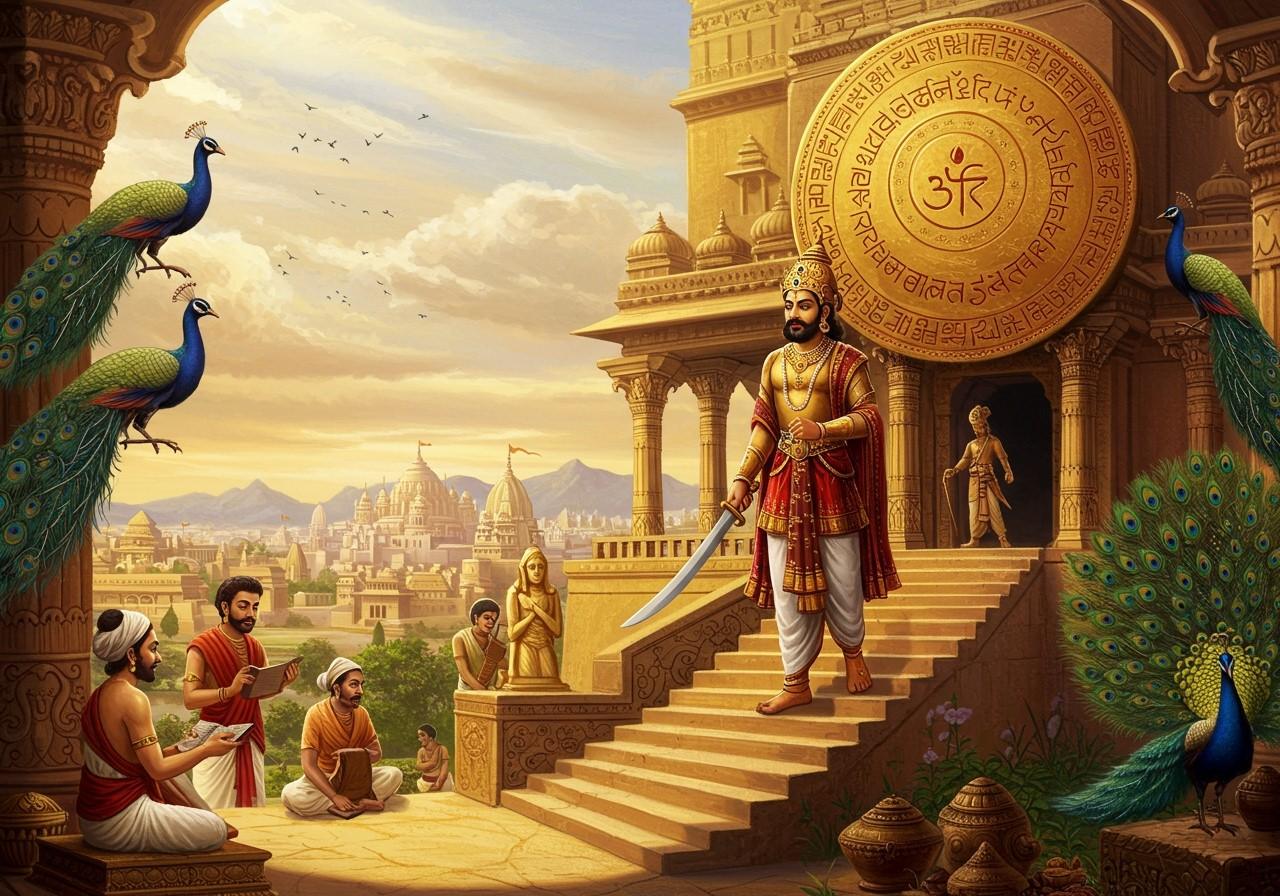
The Gupta Empire, flourishing between the mid-3rd century and mid-6th century CE, is often lauded as a golden age in Indian history. This period witnessed remarkable advancements in art, literature, science, and mathematics, placing India within a vibrant international trade network alongside empires like the Han Dynasty and the Roman Empire. This era of progress commenced with the reign of Chandragupta I, whose leadership laid the foundation for this prosperous empire. This blog post delves into the key aspects of Chandragupta I’s rule, his territorial expansion strategies, and the significance of his coinage in understanding the Gupta Empire’s rich history.
Chandragupta I’s Reign
Ascending to the throne around 320 CE, Chandragupta I marked the commencement of the Gupta Empire. His reign is characterized by political stability and economic prosperity. A pivotal moment was his marriage to Kumaradevi, a princess of the influential Licchavi clan. This strategic alliance significantly strengthened his political standing and facilitated the expansion of his kingdom.
Chandragupta I’s administration was notably efficient, establishing a centralized governance system. Trade and commerce thrived, contributing significantly to the empire’s wealth. Furthermore, his reign fostered a vibrant cultural landscape, with generous patronage extended to various art forms and scholarly pursuits. The stability and prosperity achieved during Chandragupta I’s rule set the stage for further expansion and consolidation under his successors.
Expansion Strategies of Chandragupta I
Chandragupta I employed a multifaceted approach to expand his empire:
- Strategic Marriage: His union with Kumaradevi provided control over the fertile Ganges Valley, a region crucial for resources and influence. This alliance also brought the Licchavis’ military and political support, solidifying Chandragupta’s power base.
- Diplomatic Alliances: Forging alliances with neighboring kingdoms fostered peaceful expansion and secured borders against potential threats. These alliances created a network of support and facilitated trade and cultural exchange.
- Military Campaigns: Chandragupta I led strategically planned military campaigns, minimizing resistance while maximizing territorial gains. His military prowess established him as a formidable force in the region.
- Efficient Administration: Newly acquired territories were seamlessly integrated through efficient governance, ensuring stability and loyalty. This administrative efficiency allowed for smooth transitions of power and resources.
- Trade Relations: Cultivating trade relationships with distant regions expanded the empire’s economic reach and brought in valuable resources and cultural influences. These trade networks enriched the Gupta Empire and connected it to the wider world.
- Cultural Assimilation: A focus on cultural and educational advancements fostered a sense of unity across diverse regions. This cultural cohesion strengthened the empire and promoted a shared identity.
Chandragupta I’s Coinage
The coinage of Chandragupta I offers valuable insights into his reign and the Gupta Empire:
- Material: Primarily gold, reflecting the empire’s economic prosperity and stability. The use of gold also symbolized power and prestige.
- Inscriptions: Often depicted Chandragupta I and Kumaradevi, symbolizing their powerful political alliance and the importance of the Licchavi connection. These inscriptions also served as official declarations of royal authority.
- Artistic Engravings: The high level of artistry demonstrated on the coins reflects the flourishing artistic culture during Chandragupta I’s reign. This artistry is a testament to the skilled craftsmanship of the era.
- Motifs and Symbols: The motifs and symbols on the coins provide a glimpse into the cultural and religious beliefs prevalent during this period. These symbols offer valuable insights into the religious and philosophical landscape of the Gupta Empire.
These coins served not only as currency but also as symbols of imperial authority and artistic achievement.
The Gupta Golden Age
Chandragupta I’s reign laid the groundwork for the Gupta golden age (mid-3rd to mid-6th century CE), a period of unprecedented advancements. This era witnessed remarkable achievements in various fields:
- Literature: Scholars like Kalidasa enriched Sanskrit literature, creating timeless classics.
- Science and Mathematics: Groundbreaking advancements were made, including the development of the concept of zero and significant contributions to astronomy.
- Architecture: Architectural marvels like the temples at Sanchi and Udayagiri showcase the artistic and engineering prowess of the era.
- Trade and Commerce: Flourishing trade facilitated cultural exchange with distant lands, enriching the empire’s cultural tapestry.
Connecting with the Gupta Legacy through Puja Items
At poojn.in, we offer a curated selection of authentic puja items that connect you with India’s rich spiritual heritage. Enhance your ceremonies honoring the Gupta period’s cultural richness with these offerings:
- Chand Mala (Paper): Available in various sizes, these decorative garlands symbolize the artistic excellence of the Gupta era. Perfect for adorning deity idols during pujas.
- Ashan-Anguri-Madhuparker Bati: Traditional seating and ritual accessories that maintain the authenticity of ancient Hindu ceremonies, reflecting the customs of the classical period.
- Sacred Threads: Choose from cotton threads in auspicious colors, essential for various rituals: white (Sada Suto) for purity and red (Lal Suto) for prosperity.
- Sajer Drobbo: A complete set of traditional decorative items for reverent deity worship.
All items are carefully selected and quality-checked to meet traditional standards. Visit poojn.in or contact our customer service for assistance. We offer secure, pan-India delivery to preserve the sanctity of your ritual items.
Conclusion
Chandragupta I’s reign stands as a pivotal moment in Indian history, ushering in the Gupta golden age. His strategic acumen, military achievements, and administrative reforms laid the foundation for an era of prosperity, cultural flourishing, and intellectual growth. His legacy, carried forward by his successors, solidified the Gupta Empire’s position as a beacon of progress and achievement in ancient India.


